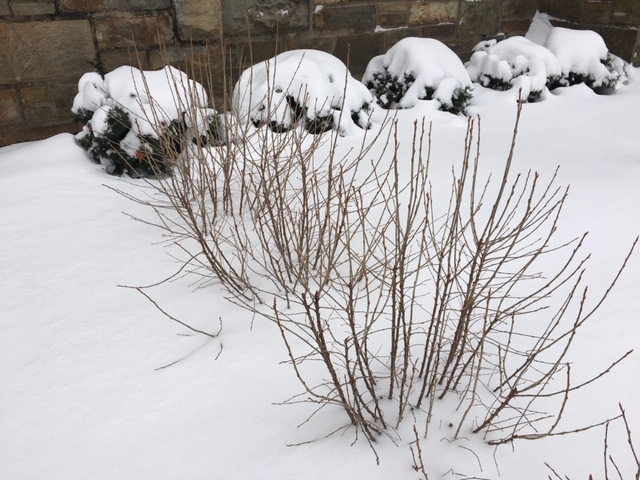
As I write this, it’s 18 degrees below zero (F) where I live on the edge of Chicago, thanks to a nasty little twitch in the polar vortex. If you are someplace warmer and want to enjoy some schadenfreude about our near-record cold, you’ll find plenty of shivery photos here.
Am I concerned about the weather? Well, I am somewhat concerned about the boiler repairman who says he’s waiting for a part. I’m a little worried about whether my car will start in the morning, when it is predicted to be four or five degrees colder. But one thing I’m not worried about is my plants.
Most garden plants around here are safely dormant. The deciduous woody plants—shrubs and trees—dropped their leaves months ago. They let most of the water in their cells subside down into their roots where it won’t freeze. The majority of these plants have already formed flower and leaf buds for spring, but the buds are armored in bud scales for protection. Trunks and branches are wrapped in bark.
The herbaceous perennial plants went farther. They allowed all their top growth to die, keeping only the roots, which are protected by the soil. Other plants survive the winter only as dormant seeds, nestled in the leaf litter.
The plants and their roots are extra snug because just before the Arctic blast hit, we got a couple of nice snowfalls. There’s a foot or more of snow on the ground. Snow is dandy insulation—after all, it’s 80 or 90 percent air, mixed with some lacy ice crystals. No matter what the air temperature is, the temperature at soil level under a good layer of snow will stay close to freezing, or 32 degrees above zero.
Even evergreen ground cover plants that don’t go fully dormant, such as ivy and hellebores, will be just fine under the snow. When it melts, they’ll emerge green and unruffled. My plants suffer more in winters when we don’t have snow cover.
The snow can be heavy, weighing down the branches of some evergreen shrubs. That makes them the most vulnerable plants in weather like this—not because the snow will really damage them, but because some anxious gardeners can’t resist trying to help. People who shake or brush the snow off their shrubs often break the branches they’re trying to save, because the cold makes the wood so brittle. Left alone until the snow melts, the branches will nearly always bounce back to shape.
Tall evergreen trees such as spruces and firs don’t keep a burden of snow because their conical form of layered branches is made to shed it. Snow slides off like a skier down a slope.
The snow serves another important purpose for Midwestern plants: By holding the soil temperature stable, it keeps them dormant during the warm spells that are as much a part of our wildly variable climate as cold snaps. It’s predicted that on Monday, the temperature will rise to 52 degrees—a swing of some 70 degrees over a couple of days. Then it will swing to cold again. Plants whose roots are exposed, without snow or mulch to insulate them, can be seriously confused by that sort of thing.
The only plants I coddle at a time like this are the houseplants indoors. Tropical plants can be nipped by the cold that travels through a windowpane (even with a storm window) or the glass of a conservatory. So I’ve moved them all a foot or two away from the glass.

Outdoors, I keep a layer of mulch over my plants’ roots, but that’s all the protection I offer. I don’t wrap anything in burlap or, God forbid, plastic foam rose cones. As far as I’m concerned, a plant isn’t worth keeping if it’s so tender it has to be made hideous for six months of the year. The key to a successful garden is being realistic about your conditions and choosing plants that are suited to them.
At least that’s my official credo, although I don’t quite live up to it. I still have some bigleaf hydrangeas (Hydrangea macrophylla), which may not bloom this spring. Their flower buds, which are sticking up out of the snow, aren’t sufficiently armored to survive a Chicago winter and have probably been killed. Maybe this will be the spring I finally get enough sense to give up on them.
Come April, I may see some brown branches on evergreens—not from the cold, most likely, but from the salt we use to melt ice on the streets and sidewalks. Salt dries out plants’ tissues.
Most plants will be fine. By April, they’ll be leafing out and blooming, as if there never were a Thursday when I risked frostbite to try and start my car.










